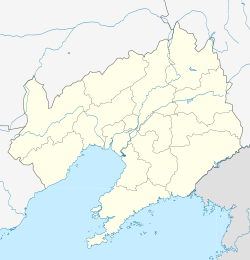Liaoyang
|
Liaoyang 辽阳市 |
|
|---|---|
| Prefecture-level city | |

White Pagoda (Baita) in Liaoyang
|
|
 Location of Liaoyang City jurisdiction in Liaoning |
|
| Location of the city centre in Liaoning | |
| Coordinates: 41°16′N 123°11′E / 41.267°N 123.183°ECoordinates: 41°16′N 123°11′E / 41.267°N 123.183°E | |
| Country | People's Republic of China |
| Province | Liaoning |
| Municipal seat | Baita District |
| Districts |
List
|
| Government | |
| • CPC Secretary | Wang Fengbo |
| • Mayor | Pei Weidong |
| Area | |
| • Prefecture-level city | 4,731 km2 (1,827 sq mi) |
| • Urban | 210 km2 (80 sq mi) |
| Elevation | 29 m (95 ft) |
| Population (2010 census) | |
| • Prefecture-level city | 1,859,768 |
| • Density | 390/km2 (1,000/sq mi) |
| • Urban | 527,850 |
| Time zone | China Standard (UTC+8) |
| Postal code | 111000 |
| Area code(s) | 419 |
| Licence plates | 辽K |
| Administrative division code | 211000 |
| ISO 3166-2 | cn-21-10 |
| Website | http://www.liaoyang.gov.cn |
Liaoyang (simplified Chinese: 辽阳; traditional Chinese: 遼陽; pinyin: Liáoyáng) is a prefecture-level city of east-central Liaoning province, People's Republic of China, situated on the T'ai-tzu River and, together with Anshan, forms a metro area of 2,057,200 inhabitants in 2010. It is approximately one hour south of Shenyang, the provincial capital, by car. Liaoyang is home to Liaoning University's College of Foreign Studies and a number of vocational colleges. The city hosts a limited number of professional basketball and volleyball games in a modern sports facility.
Liaoyang is one of the oldest continuously-inhabited cities in northeast China, dating back to before the Spring and Autumn period. During the Chinese Tang dynasty, Liaoyang was part of the northern edge of the Goguryeo kingdom. Remains of Yodong and Baegam cities, the old Goguryeo cities, can still be seen near the modern city. This was the site of a major battle between the Tang and Goguryeo in 645 AD. Goguryeo (an antecedent of modern Korea) ruled the area from the early 5th to the mid-7th century.
Liaoyang rose to prominence during the Liao dynasty. Several buildings in the city date to this period. Among these is the White Pagoda (baita), which dates back to 1189 in the Liao Dynasty with additions during the Yuan dynasty. The Liaoyang White Pagoda sits in Baita Park within Baita district in the centre of the city. Next to the park is Guangyou Temple, one of the oldest and largest temple complexes in the north east of China covering some 60,000 square metres (650,000 sq ft).
Under the Jurchen Jin dynasty, the city served as their empire's eastern capital under the name Dongjing (東京).
...
Wikipedia

